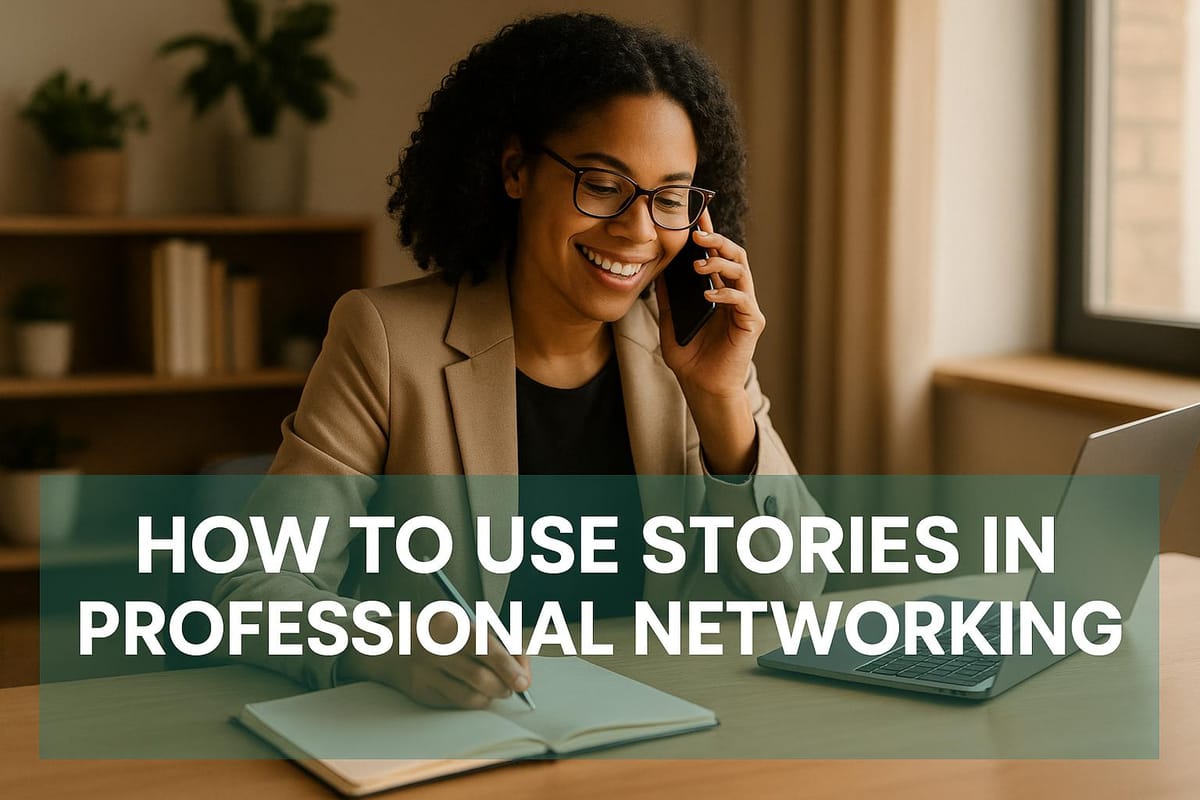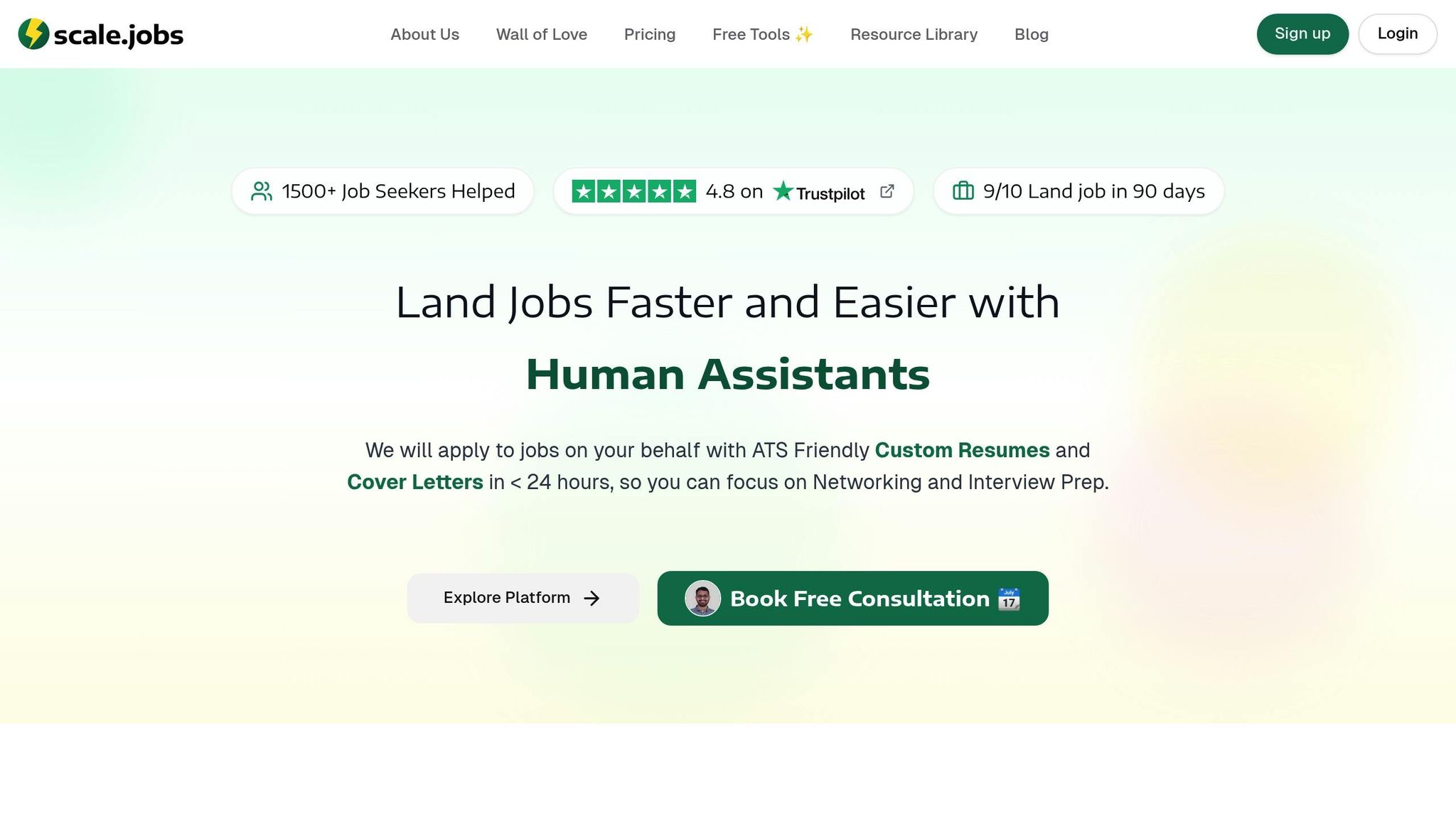How to Use Stories in Professional Networking
Harness the power of storytelling to enhance your professional networking skills and build lasting connections.

Want to stand out in professional networking? Start telling stories. Storytelling is a powerful way to connect with others, make yourself memorable, and highlight your skills during networking conversations. Here’s what you need to know:
- Why stories work: People remember narratives better than facts. A good story makes you relatable and leaves a lasting impression.
- Build your personal brand: Stories show how you solve problems, make decisions, and grow professionally. They reveal your values and create trust.
- How to structure a story: Use the simple formula: Situation, Action, Result. Keep it specific and concise.
- Tailor your story to the audience: Adjust your tone and details based on the setting - casual chats, formal events, or industry-specific gatherings.
- Practice matters: Refine your delivery, focus on body language, and have multiple versions ready for different scenarios.
Storytelling isn’t just about sharing your achievements; it’s about connecting with others on a deeper level. Whether you’re job hunting, switching careers, or advancing in your field, stories can open doors and create opportunities.
Use STORYTELLING for NETWORKING | Real-Life Story
Building Your Personal Brand Story
Developing a compelling brand story that aligns with your career goals is a game-changer. A well-crafted story not only highlights your skills but also connects with your audience, making it an essential tool in today’s competitive job market.
The key to effective networking stories lies in purpose. These aren’t just casual anecdotes - they’re intentional narratives designed to showcase your value while resonating with the interests of your listeners. The next step is learning how to structure, choose, and deliver these stories with impact.
How to Structure a Good Story
A strong networking story follows a simple, three-part structure that keeps your audience engaged:
- Situation: Set the stage by explaining the challenge or opportunity you encountered.
- Action: Share the specific steps you took to address the situation.
- Result: Highlight the outcome and reflect on what you learned.
For example, if you’re discussing a challenging project, start by describing the context - perhaps your team was tasked with launching a new product feature under a tight deadline. Then, explain how you coordinated efforts across departments to meet that deadline. Finally, share the results, such as the successful launch and key takeaways that improved future workflows.
Specificity is crucial. Instead of saying, "I improved team communication", detail how you introduced weekly stand-up meetings that boosted collaboration. Replace vague phrases like "a successful campaign" with concrete outcomes, such as "a social media strategy that increased engagement by 40% over three months."
Your story should always align with your networking goals. For instance, if you’re targeting project management roles, focus on examples that highlight your leadership and organizational skills. If you’re pursuing sales, share stories that demonstrate your ability to build relationships and achieve measurable results.
Aim to keep your story concise - around one minute is perfect. This ensures you cover all the key elements without losing your listener’s attention.
Picking the Right Story for Each Situation
Not all networking situations are the same, and successful storytellers adapt to their environment. The story you share during a casual coffee chat will differ from one told at a formal industry event.
In informal settings, lean into stories that reveal your personality while showcasing your skills. These moments call for authenticity over polish. For example, you might share how you adapted to a project setback or mastered a new skill through trial and error.
At formal networking events or conferences, opt for polished narratives that highlight your professional value. This is the time to emphasize clear accomplishments, leadership experiences, or innovative solutions you’ve implemented. These audiences value strategic thinking and tangible results.
For industry-specific gatherings, dive deeper into technical details or specialized challenges. Use language and examples that reflect your expertise in that field. These nuances may not resonate as strongly with a general audience but will leave a lasting impression on those familiar with your industry.
Tailor your story to your audience’s level of experience. For example, recent graduates might focus on their adaptability, internships, or academic projects that translate to workplace skills. Seasoned professionals, on the other hand, can draw on leadership roles, mentoring experiences, or stories about navigating industry changes.
Practicing and Improving Your Delivery
Practice is what turns a good story into an unforgettable one. It helps you sound natural and confident rather than rehearsed.
Start by recording yourself and practicing in front of different people to refine your delivery. Pay attention to which parts spark engagement or lead to questions, and use that feedback to make your story even better. Be mindful of timing - keeping your story concise ensures it holds your listener’s attention.
Your body language is just as important as your words. Maintain eye contact, use natural hand gestures, and keep an open posture to convey confidence and make your story more engaging.
Smooth transitions are another key element. Phrases like, "That reminds me of a project I worked on", can help you naturally weave your story into conversations without it feeling forced.
Finally, prepare multiple versions of your stories. A short version works well for quick exchanges, while a more detailed version is ideal for in-depth discussions. This flexibility ensures you’re ready to adapt to any situation.
Telling Stories Well in Networking Conversations
The way you tell a story can make all the difference between leaving a lasting impression or being quickly forgotten. A well-told story not only helps people remember information but also strengthens your personal brand, making it a powerful tool for professional networking.
Connecting with Your Audience Through Storytelling
The foundation of meaningful storytelling is active listening. Pay close attention to what your conversation partner shares - whether it’s their challenges, interests, or goals. This insight helps you tailor your stories to their context, creating a deeper connection.
For example, if someone mentions struggling with team communication, you could share a story about how you turned around a dysfunctional project team. The key is to make your narrative feel natural and relevant, not like a rehearsed monologue.
After sharing your story, keep the dialogue alive by asking, "Have you ever faced something similar?" This shifts the interaction from a one-sided presentation to a two-way conversation.
Storytelling also taps into biology. Stories trigger the release of oxytocin, a hormone linked to trust and bonding. To harness this, infuse genuine emotion into your narratives. Share not just what happened, but how it made you feel, the decisions you faced, and the lessons you learned. Vulnerability makes your story relatable and builds trust.
Craft your characters with depth and complexity, including your own flaws or moments of uncertainty. Instead of portraying yourself as a perfect hero, share the missteps or doubts you experienced along the way. Authenticity resonates far more than a polished tale of unbroken success.
Keep in mind that the setting of your conversation plays a big role in how you tell your story.
Adjusting Stories for Different Networking Settings
The way you tell a story should adapt to the environment and the size of your audience. A one-on-one conversation allows for personal, detailed storytelling, while larger settings call for a more focused, concise approach.
- One-on-one conversations: These intimate exchanges are ideal for diving into the emotional journey of your story. You can describe the sleepless nights before a big presentation or the moment you realized your strategy needed a complete overhaul. These personal details create a stronger connection.
- Small group settings: With three to five people, your story needs to engage multiple personalities. Focus on universal themes, like overcoming challenges or learning from mistakes, that resonate with everyone in the group. Keep the tone conversational and inclusive.
- Larger networking events: At conferences or industry gatherings, brevity is key. Condense your story to its essential points while maintaining its impact. Introduce challenges or obstacles early to grab attention, and highlight the skills and outcomes that demonstrate your expertise.
Tailor your narrative to fit the situation: go deep and personal in close conversations, focus on shared experiences in small groups, and keep it sharp and impactful for larger audiences.
Using Stories to Show Your Skills and Achievements
Stories aren’t just for making connections - they’re a great way to showcase your skills and accomplishments. Instead of simply stating your achievements, frame them as part of a problem-solving journey. For example, instead of saying, "I increased sales by 30%, explain how you identified the root cause of declining performance, implemented a creative solution, and measured the results.
Whenever possible, quantify your impact. For instance, instead of saying you "improved efficiency", share how you reduced processing time from 48 hours to 6 hours, saving your company $50,000 annually. Specific numbers make your story more credible and memorable.
When discussing career milestones, present them as pivotal moments in your professional growth. Talk about the steps you took to transition into leadership, the skills you developed, and how those experiences shaped your career path.
If you’re networking outside your current field, emphasize transferable skills like project management, strategic thinking, or stakeholder communication - skills that apply across industries. Avoid overly technical details that may not resonate with your audience.
Prepare a collection of short, relevant anecdotes that highlight different strengths, such as leadership, problem-solving, adaptability, or teamwork. This variety ensures you’re ready for any topic that comes up in conversation.
To keep your stories engaging and structured, use the IRS format:
- Start with an intriguing opening that captures attention.
- Build tension in the middle by describing the challenges and how you addressed them.
- End with a satisfying conclusion that highlights your results and the lessons you learned.
This approach ensures your stories are not only engaging but also effectively communicate your value and help you stand out in any networking situation.
Solving Common Storytelling Problems
As you refine your storytelling skills, it's important to address common challenges that can arise. Even experienced professionals sometimes struggle to strike the right balance between being genuine and meeting professional objectives when sharing stories in networking or professional settings.
Staying Genuine While Meeting Your Goals
One of the biggest hurdles in storytelling is maintaining authenticity while ensuring your narrative aligns with your professional goals. You want to present yourself in the best light without coming across as insincere or overly polished. Here are some ways to navigate this:
Start by identifying the values and experiences that naturally align with your goals. For instance, if you're passionate about problem-solving, share a story about a time you introduced a creative solution or challenged the norm. These stories resonate because they reflect your true self while showcasing your strengths.
Stick to the emotional truth of your experiences instead of exaggerating details to make them sound more impressive. If a project had its ups and downs, don’t shy away from mentioning the challenges. Highlight how you adapted and what you learned. This honesty builds trust and makes your story relatable.
Ask yourself: "Would I tell this story to a close friend in the same way?" If the answer is no, you might be over-polishing it. Some of the most effective professional stories include moments of vulnerability or lessons learned from mistakes.
When discussing achievements, give credit where it’s due. Instead of claiming sole responsibility for a success, talk about your specific role while acknowledging the contributions of others. This not only demonstrates humility but also shows you understand the value of teamwork.
It’s also helpful to prepare different versions of the same story for various audiences. The core of the story stays the same, but you can adjust the focus. For example, emphasize decision-making for a leadership conversation or dive into technical details for a more specialized audience.
Handling Nerves and Building Confidence
Even the most well-prepared story can falter if nerves take over. Rushing through details, forgetting key points, or losing your audience’s attention are common pitfalls. Building confidence takes preparation and practice.
Beyond practicing your delivery, try these strategies to calm your nerves:
- Practice in low-pressure settings to gain comfort with your stories.
- Establish a pre-conversation routine, such as deep breathing or reviewing key points, to center yourself.
- Shift your focus to your listener. Instead of worrying about how you’re coming across, think about what would interest or benefit them. This shift can naturally ease anxiety.
Prepare smooth transitions into your stories with conversation bridges like "That reminds me of a time when..." or "I faced a similar challenge when...". These phrases make your storytelling feel natural and unrehearsed.
Lastly, create a story bank of 5-7 well-practiced narratives that highlight different skills or experiences. Having these ready reduces the pressure to come up with something on the spot and boosts your confidence in any conversation.
Avoiding Revealing Too Many Personal Details and Staying Professional
Once you’ve polished your storytelling skills, it’s crucial to ensure your content remains professional and focused. The line between engaging and oversharing can blur, especially when nerves or enthusiasm take over.
Adjust the length of your stories to fit the context. For quick interactions, stick to a 30–45 second version and avoid overly personal topics like family issues or health challenges. Focus on work-related experiences, and pay attention to your listener’s reactions to gauge their interest.
Keep your stories professionally relevant. Even personal anecdotes should tie directly to qualities or skills that matter in your field. For example, a story about organizing a community event can highlight leadership and project management, but avoid unnecessary personal details.
Be mindful of confidentiality. Never share sensitive information about former employers, clients, or internal company matters. Instead, focus on the lessons learned without compromising professional boundaries.
Finally, apply the ‘elevator test’: if you wouldn’t share a story with a colleague in a brief elevator ride, it’s probably best to leave it out.
Using Job Search Platforms for Networking Stories
Job search platforms have evolved into powerful tools for shaping and sharing your professional story. They’ve turned networking from a series of chance meetings into a deliberate, strategic process. Let’s take a closer look at how scale.jobs helps you craft and refine your narrative for better networking results.
How scale.jobs Enhances Networking Through Storytelling

scale.jobs simplifies the art of storytelling with a mix of advanced technology and human guidance. The platform’s AI Assistant Pro creates tailored resumes and cover letters in seconds, allowing you to adapt your story for different roles seamlessly. Each version highlights a unique aspect of your professional journey, making your applications more relevant and engaging.
For immigrant jobseekers, this is especially helpful. The platform combines AI-generated materials with coaching from reverse recruiters to fine-tune your narrative - addressing challenges like visa requirements while showcasing your strengths.
The job applications tracker is another standout feature. It helps you monitor which version of your story resonates most by tracking responses. This tool lets you document what you’ve shared with each connection, analyze feedback, and uncover patterns that can refine your approach.
For recent grads or those making a career shift, the ATS-compliant resume builder is a game-changer. It not only ensures your resume passes automated screening systems but also teaches you how to adjust your narrative for different industries and roles. This ability to adapt your story is invaluable for building strong connections during networking.
scale.jobs vs. Other Platforms: Why It Stands Out
When it comes to networking tools, not all platforms are created equal. Many focus solely on job applications, but scale.jobs integrates storytelling into the process, setting it apart. Here’s how it compares to competitors:
| Feature | scale.jobs | Find My Profession | TealHQ | LazyApply |
|---|---|---|---|---|
| Human Storytelling Coaching | Yes – flat-fee, unused-credit refunds | Yes – premium packages | No | No |
| AI Story Adaptation | Yes – unlimited adaptations | Limited | Resume optimization only | Auto-apply focus |
| Networking Tools Integration | Yes – conversation tracking | Limited | Basic job tracking | No |
| Immigrant/Visa Support | Specialized guidance | Limited | No | No |
| Real-Time Feedback | WhatsApp updates, proof screenshots | No | No | No |
| Pricing Model | $9/month AI + flat-fee human services | High recurring costs | Subscription-based | Subscription-based |
| Free Storytelling Tools | ATS checker, cover letter generator | Limited free options | Basic free tier | Limited free features |
scale.jobs excels because it combines cutting-edge technology with hands-on human support. Unlike TealHQ, which relies solely on software, scale.jobs offers personalized coaching from reverse recruiters who guide you through storytelling strategies. While LazyApply focuses on automating applications in bulk, scale.jobs prioritizes quality over quantity, ensuring your narrative stands out.
Although Find My Profession provides similar human support, it comes with much higher costs. scale.jobs delivers comparable assistance at a flat fee, making it a more affordable option for recent graduates or those navigating layoffs.
One of the platform’s most unique strengths is its focus on immigrant jobseekers. While other platforms often overlook visa-related challenges, scale.jobs addresses them head-on. Its human assistants craft stories that not only address sponsorship concerns but also highlight the unique skills and perspectives immigrant candidates bring to the table. This targeted approach can make all the difference in a competitive job market.
Getting Better at Storytelling in Networking
Becoming a skilled storyteller in networking takes practice and a willingness to adapt. Top networkers know that their stories evolve as their careers progress. They tweak their narratives to stay relevant and connect meaningfully with others.
The key to improvement? Regular practice and constructive feedback. Start by keeping a story journal to jot down your experiences. Share these stories with trusted colleagues or mentors to get their input. Begin with low-pressure settings, like casual coffee chats or informal meetings, before stepping into high-stakes networking events. For instance, Teresa Goertz transitioned from financial services to technical writing by attending STC events after earning certifications at Bellevue College. Within just 18 months, she increased her hourly pay by 58% [Remote-First Coaching, 2023].
To refine your storytelling, study how experts do it. Watch TED Talks, listen to podcasts, or attend industry conferences. Pay attention to how speakers structure their stories, use pauses effectively, and engage their audience. Then, integrate these techniques into your own storytelling while staying true to your style. Tools like scale.jobs can also help polish your narrative for different audiences.
Platforms like scale.jobs bring together AI and human expertise to take your storytelling to the next level. Its AI Assistant Pro tailors your stories for various audiences, while its networking tools track which narratives resonate most. For immigrant job seekers, scale.jobs offers human assistant services that craft stories addressing visa challenges, saving over 20 hours a week for focused networking.
Storytelling isn’t just about delivery - it’s about creating opportunities. Often, the results of networking show up months later. Tucker’s experience is a great example. At a conference, he almost skipped a networking mixer but decided to stay. That decision led him to meet Bobby, who later connected him with a vendor looking for a Project Manager. Four months after the conference, Tucker landed the job [Careers Done Write].
"Networking is not about just connecting people. It's about connecting people with people, people with ideas, and people with opportunities", says Michele Jennae.
Your storytelling journey doesn’t end once you land a role. Keep honing your skills through workshops, professional associations, and mentorship opportunities. Take Fabienne Mouton’s story: she moved to the U.S. from France without English skills or work authorization. By joining the Puget Sound Career Development Association, she not only improved her storytelling but also became president-elect. By 2023, she was Associate Director of Corporate Outreach - Career & Employment Programs at Bellevue College [Remote-First Coaching, 2023].
The best networkers combine storytelling with careful planning. They research their audience, tailor their narratives, and follow up consistently. Whether you’re a recent graduate, career changer, or seasoned professional, investing in your storytelling skills can open doors throughout your career. With consistent effort and the right tools, professional networking becomes a powerful game-changer.
FAQs
How can I adjust my storytelling to connect with different audiences while networking?
To truly connect with various audiences, it's important to shape your storytelling around their interests, needs, and how much they already know about the topic. In professional or highly detailed settings, stick to clear, concise, and fact-based storytelling. On the other hand, in more personal or creative spaces, weaving in relatable experiences and emotional touches can make your story stick.
Think about elements like tone, complexity, and structure, adjusting them to fit your audience and the situation. A helpful tool is the 5Ps framework - People, Place, Pictures, Personal, Platform - which helps you create stories that engage and resonate. By tailoring your approach, your message becomes more relevant and impactful, paving the way for stronger connections in your professional relationships.
How can I overcome nervousness and confidently share my story at networking events?
To tackle nervousness and share your story with confidence at networking events, preparation is key. Start by practicing your introduction and key points until they feel second nature. This not only boosts your confidence but also ensures you come across as composed and authentic.
Instead of focusing solely on self-promotion, aim to build genuine connections. When you share your story in a way that feels real and relatable, it leaves a lasting impression. Incorporating storytelling techniques can help highlight your experiences and the lessons you've learned, adding depth and making your narrative more engaging.
Before the event, try calming your nerves with mindfulness exercises like deep breathing or visualization. These simple techniques can help you feel more grounded. It also helps to set a clear goal for why you're attending - this keeps your focus sharp and reduces anxiety. Over time and with consistent practice, sharing your story will start to feel second nature, even in challenging situations.
How can I share personal stories during networking while staying professional?
When sharing personal stories during networking, choose experiences that showcase your skills, accomplishments, or the lessons you've gained along the way. Make sure your stories tie directly to your career goals and avoid delving into overly personal or sensitive details.
Keep your tone professional yet approachable, and ensure your story leaves the impression you want to convey. By staying relevant and purposeful, you can create meaningful connections while highlighting your expertise and professionalism.




